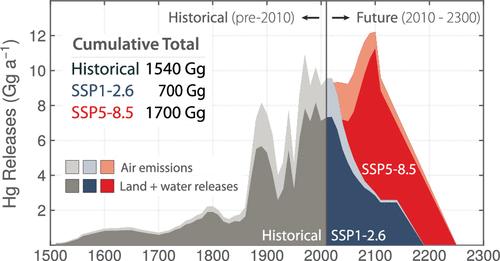过去和未来的人为排放和释放对全球汞循环的累积影响
IF 11.3
1区 环境科学与生态学
Q1 ENGINEERING, ENVIRONMENTAL
引用次数: 0
摘要
几千年来,人类故意从地球岩石圈中开采和释放汞。在这里,我们综合了过去、现在和未来的人为汞排放和释放,并使用全球地球化学盒模型来表征大气、陆地和海洋中的汞积累。我们预计排放和释放的上限在2010年至2300年之间(共享社会经济途径(SSP)5-8.5;1.7 Tg),超过了过去五千年的历史总量(1.5 Tg)。相比之下,排放和释放的下限(SSP1-2.6;0.7 Tg)大大小于历史总量。全球模拟的观测限制表明,在2010年之前释放到陆地和水中的大多数汞仍然被隔离在污染地点。人为汞对海洋的大量富集(约2010年为270%)主要是由大气排放驱动的。预计未来向陆地和水中的累积排放大约是人为向大气排放的主要排放量的六倍。这些汞主要被隔离在遗留的汞废物池中,除非被气候变化调动起来,否则不太可能影响全球海洋中的汞污染。模拟结果表明,如果社会遵循SSP5-8.5,到2100年大气汞浓度可能与目前的水平相似。在SSP1-2.6下,预计表层海洋(- 19%)和大气(- 45%)的下降,强调了减少未来汞释放的好处。本文章由计算机程序翻译,如有差异,请以英文原文为准。

Cumulative Anthropogenic Impacts of Past and Future Emissions and Releases on the Global Mercury Cycle
Humans have intentionally mined and released mercury (Hg) from the Earth’s lithosphere over millennia. Here, we synthesize past, present, and future anthropogenic Hg emissions and releases and use a global geochemical box model to characterize accumulation in the atmosphere, land, and ocean. We project an upper-bound for emissions and releases between 2010 and 2300 (Shared Socioeconomic Pathway (SSP)5-8.5; 1.7 Tg) that surpasses the historical total over the past half millennium (1.5 Tg). In contrast, the lower-bound for emissions and releases (SSP1-2.6; 0.7 Tg) is substantially smaller than the historical total. Observational constraints on global modeling suggest that most Hg released to land and water prior to 2010 remains sequestered at contaminated sites. Substantial oceanic enrichment by anthropogenic Hg (270% ca. 2010) has been driven mainly by atmospheric emissions. Cumulative future releases to land and water are projected to be approximately six-times greater than primary anthropogenic emissions to the atmosphere. This Hg is mainly sequestered in legacy Hg waste pools and is unlikely to impact Hg pollution in the global ocean unless it is mobilized by climate change. Modeling results suggest that by 2100 atmospheric Hg concentrations may be similar to present levels if society follows SSP5-8.5. Declines in the surface ocean (−19%) and atmosphere (−45%) are expected under SSP1-2.6, emphasizing the benefits of reductions in future Hg releases.
求助全文
通过发布文献求助,成功后即可免费获取论文全文。
去求助
来源期刊

环境科学与技术
环境科学-工程:环境
CiteScore
17.50
自引率
9.60%
发文量
12359
审稿时长
2.8 months
期刊介绍:
Environmental Science & Technology (ES&T) is a co-sponsored academic and technical magazine by the Hubei Provincial Environmental Protection Bureau and the Hubei Provincial Academy of Environmental Sciences.
Environmental Science & Technology (ES&T) holds the status of Chinese core journals, scientific papers source journals of China, Chinese Science Citation Database source journals, and Chinese Academic Journal Comprehensive Evaluation Database source journals. This publication focuses on the academic field of environmental protection, featuring articles related to environmental protection and technical advancements.
 求助内容:
求助内容: 应助结果提醒方式:
应助结果提醒方式:


